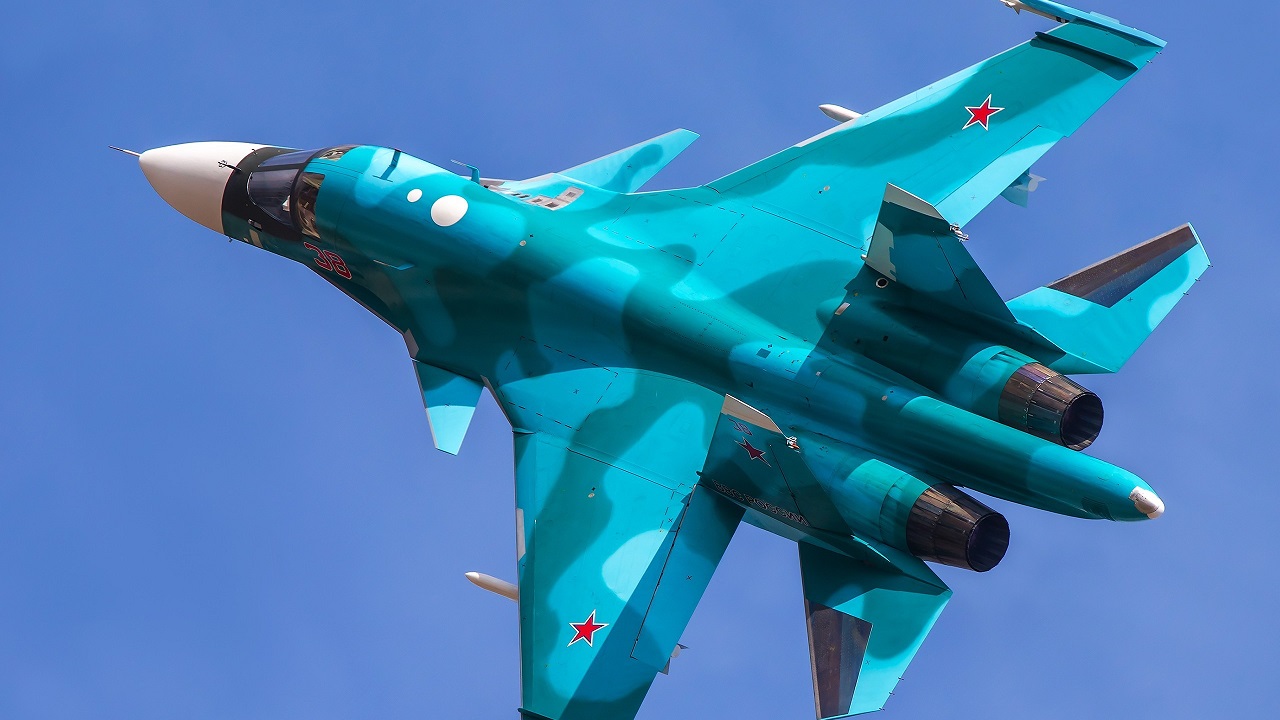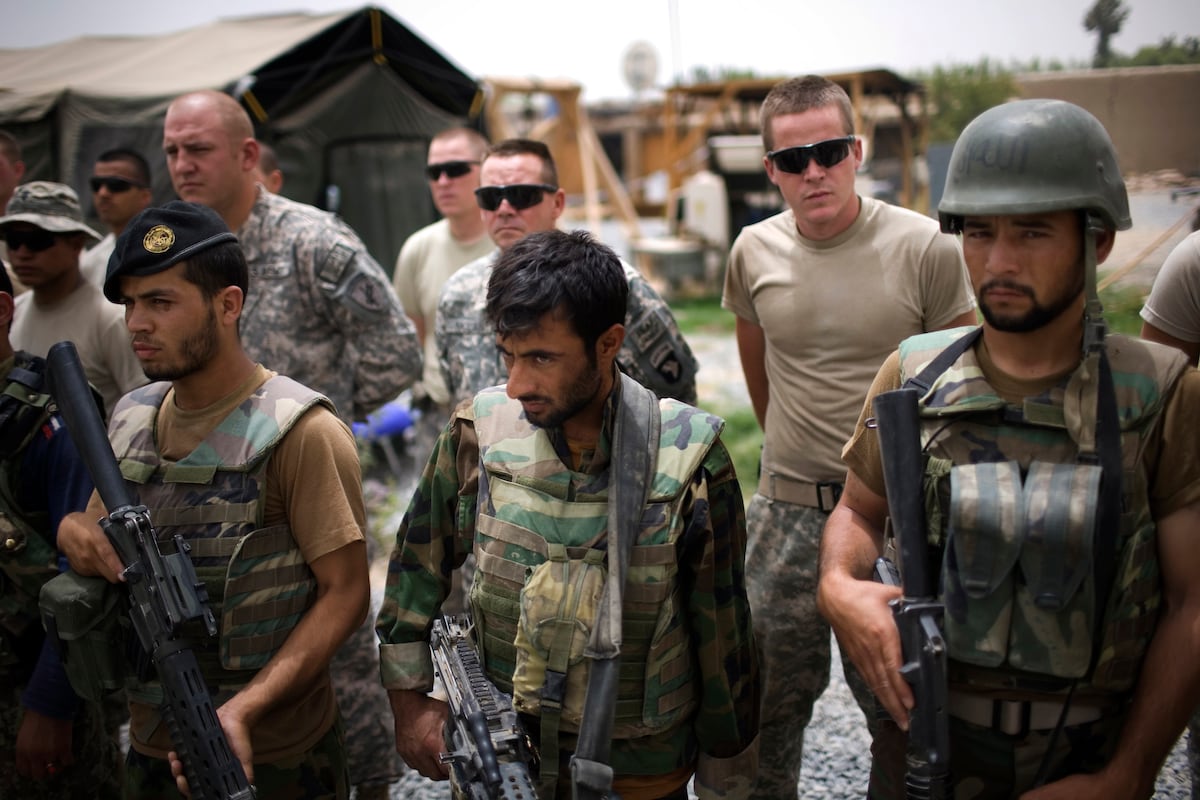The Sukhoi Su-34 Fullback: Anatomy of Russia’s Fighter-Bomber
Introduction – A Cold War Platypus in a 21st Century World
The Sukhoi Su-34, known to NATO as the “Fullback,” is an aircraft of inherent contradictions. Officially entering service with the Russian Aerospace Forces (VKS) in 2014, it presents as a modern, 4++ generation strike platform.
Su-34 Fullback. Image Credit: Creative Commons.
Yet, its conceptual DNA is deeply rooted in the final, turbulent years of the Soviet Union, a product of a military requirement from a bygone era.
This protracted, 24-year journey from its maiden flight to full operational status is not merely a historical footnote; it is the central factor that defines the Su-34’s unique strengths, its glaring weaknesses, and its complex, often controversial, combat record.
It is, in essence, a machine conceived to fight one war, which found itself fighting a very different one decades later.
The Soviet Requirement
The story of the Su-34 begins in the late 1970s and early 1980s, as the Soviet Air Force sought a modern, long-range successor to its aging fleet of tactical bombers.
The primary aircraft to be replaced was the venerable swing-wing Sukhoi Su-24 “Fencer,” but the new platform was also envisioned to take over missions performed by the MiG-27 “Flogger” ground-attack aircraft and the heavily armored Su-25 “Frogfoot” close air support jet.
The requirement called for a versatile, all-weather aircraft capable of deep penetration into enemy airspace, precision strikes against ground and naval targets, and robust self-defense capabilities to operate in a hostile environment.
The Flanker as a Foundation
To meet this demanding set of requirements, the Sukhoi Design Bureau selected its highly successful Su-27 “Flanker” air superiority fighter as the foundational airframe.
The choice was logical; the Su-27 possessed exceptional range, a large payload capacity, and impressive maneuverability, providing a robust and proven starting point for a new fighter-bomber variant.
The project, known internally as T-10V, commenced with the modification of an Su-27UB two-seat trainer, which was transformed into the first prototype, designated the Su-27IB (Istrebitel-Bombardirovshchik, or “Fighter-Bomber”).
A Protracted Birth
This prototype, T-10V-1, made its maiden flight on April 13, 1990, with pilot Anatoly Ivanov at the controls.
However, what should have been the start of a relatively swift development and production cycle was catastrophically derailed by the political and economic turmoil of the Soviet Union’s collapse. The program stalled for over a decade due to a severe lack of funding, with state trials only concluding in 2003 and full-scale production at the Novosibirsk aircraft plant beginning in earnest around 2008.
The Su-34 was finally commissioned into formal service on March 14, 2014, nearly a quarter-century after it first took to the skies.
This immense delay created a fundamental mismatch between the aircraft’s core design and the threats it would ultimately face. The Su-34 was conceived as a heavily armored, low-level penetrator designed to survive the dense but technologically simpler NATO air defenses of the 1980s.
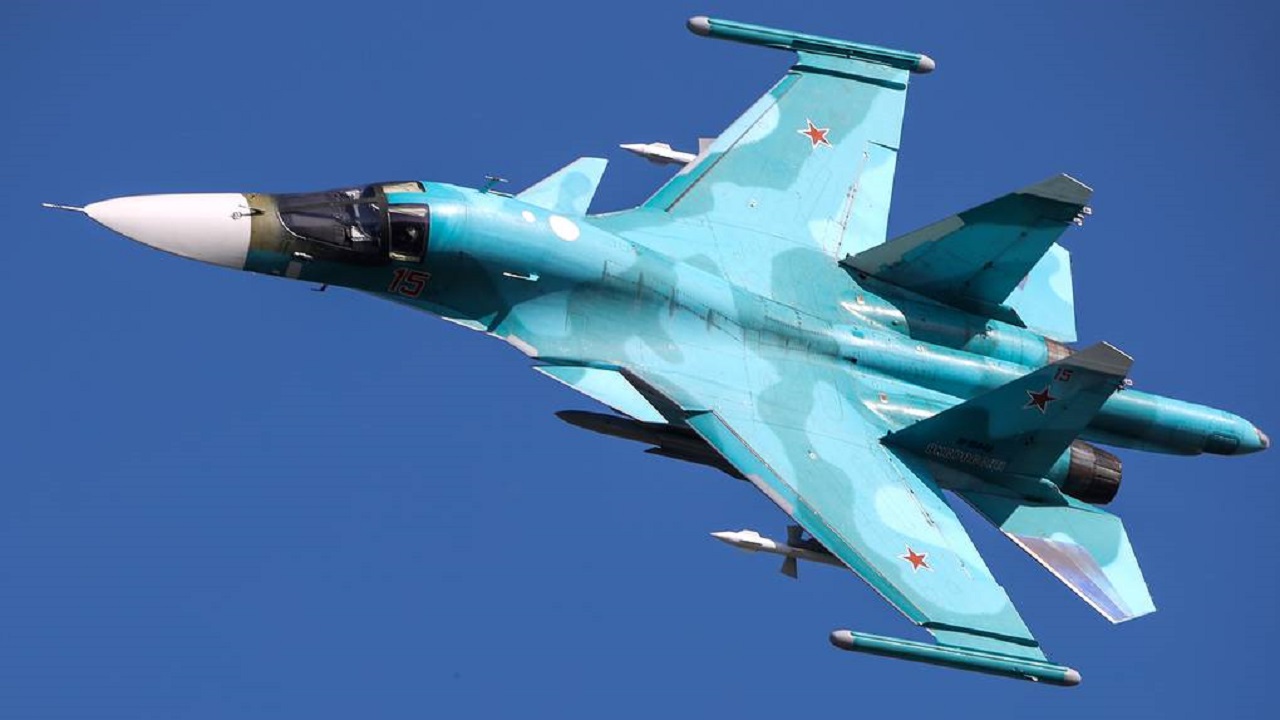
Su-34 fighter. Image Credit: Russian Government.
When the program was revitalized in the 2000s, modern avionics were essentially integrated into this older airframe concept.
The result was a hybrid platform that was neither a clean-sheet 21st-century design nor a simple legacy upgrade. This inherent tension helps explain why the aircraft performed well in the low-threat environment of Syria, which more closely mirrored its original design parameters, but struggled against the modern, networked, and electronically sophisticated air defenses it encountered in Ukraine. The subsequent and urgent development of the modernized Su-34M variant is not a routine upgrade, but a reactive attempt to correct this foundational mismatch and adapt the aircraft to a battlefield its original designers could not have fully anticipated.
Its unique physical appearance, born from its specialized role, earned it the affectionate Russian nickname Utkonos (“Platypus”) or Utyonok (“Duckling”) due to its distinctive flattened nose cone, while NATO assigned it the more imposing reporting name “Fullback”.
Anatomy of a Hellduck: Design, Technology, and Crew Endurance
The Su-34’s design is a masterclass in trade-offs, where every major feature is optimized for its primary role as a long-range, survivable strike platform. This specialization makes it a formidable weapon system within its intended operational envelope but also creates vulnerabilities when it is forced to operate outside of it.
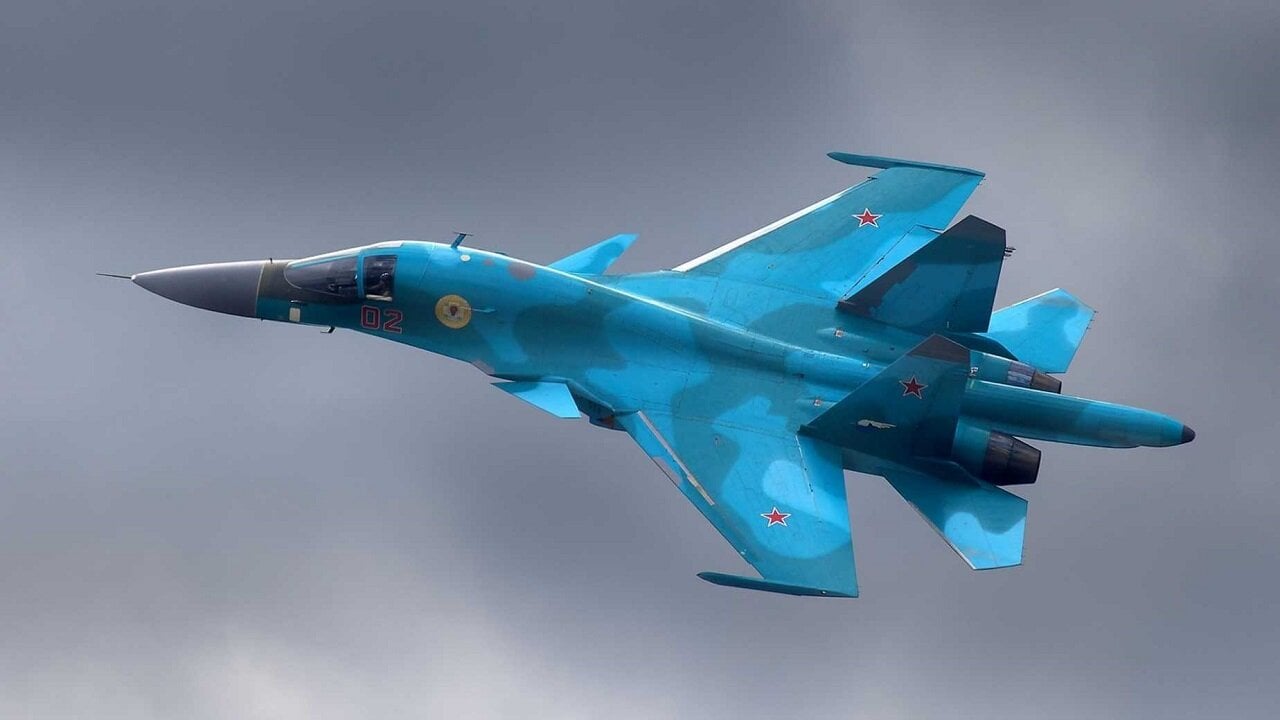
Su-34 Fullback. Image Credit: Creative Commons.
Airframe and Aerodynamics
While based on the Flanker, the Su-34’s airframe features significant modifications. It retains the basic wing structure, tail, and engine nacelles of the Su-27/Su-30 family but incorporates a “three-surface” aerodynamic layout with canard foreplanes.
These canards, similar to those on the Su-30MKI and Su-33, increase static instability for higher maneuverability and provide additional lift, which enhances stability during low-altitude flight and reduces trim drag.
In a key departure from the high-altitude Su-27, the Su-34 uses fixed-geometry air inlets. This design choice sacrifices peak performance at high Mach numbers and high altitudes in favor of optimizing efficiency for low-to-medium altitude penetration missions.
To support a significantly higher maximum takeoff weight of up to 45,100 kg, the landing gear was substantially reinforced, featuring a twin-wheel nose unit and robust main gear with tandem wheels on each strut, enabling operations from less-prepared or austere airfields.
The Armored Office: A Cockpit Built for Endurance
The most radical and defining feature of the Su-34 is its cockpit.
The traditional tandem seating of the Su-27UB was replaced with an entirely new, wider forward fuselage that accommodates the pilot and weapon systems officer (WSO) in a side-by-side configuration.
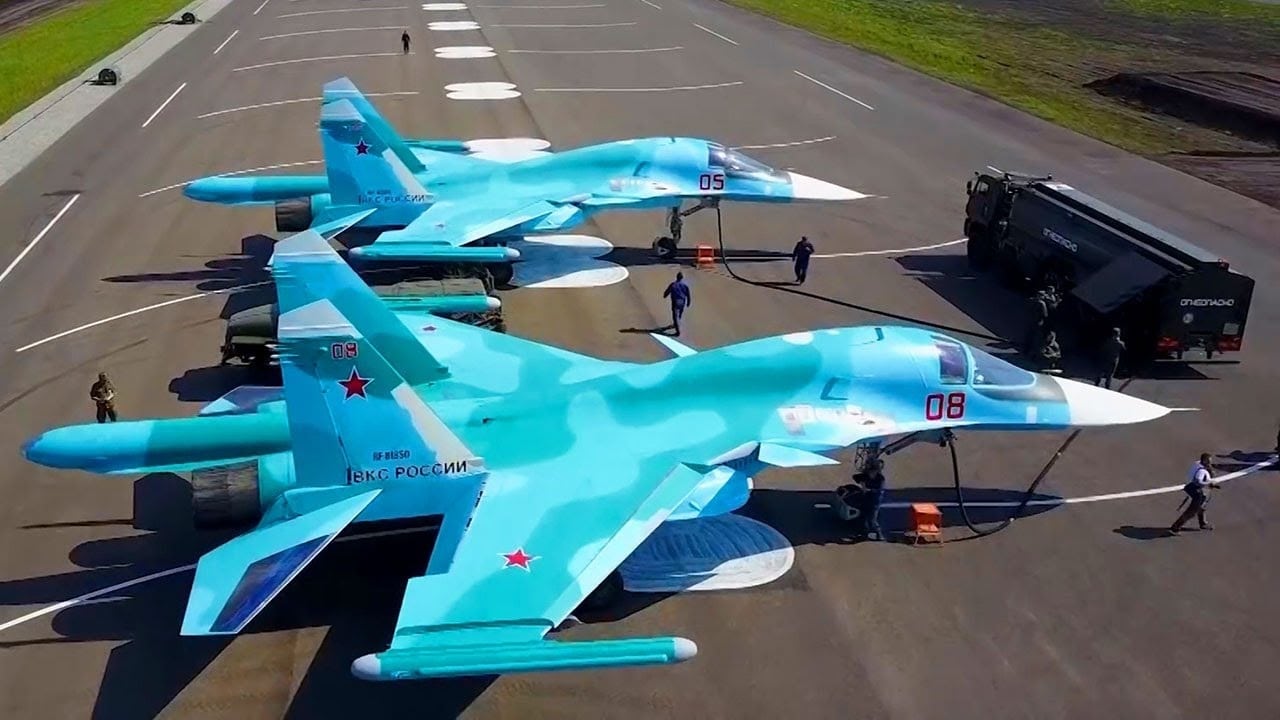
Russian Military Su-34 Fighter-Bomber. Image Credit: Creative Commons.
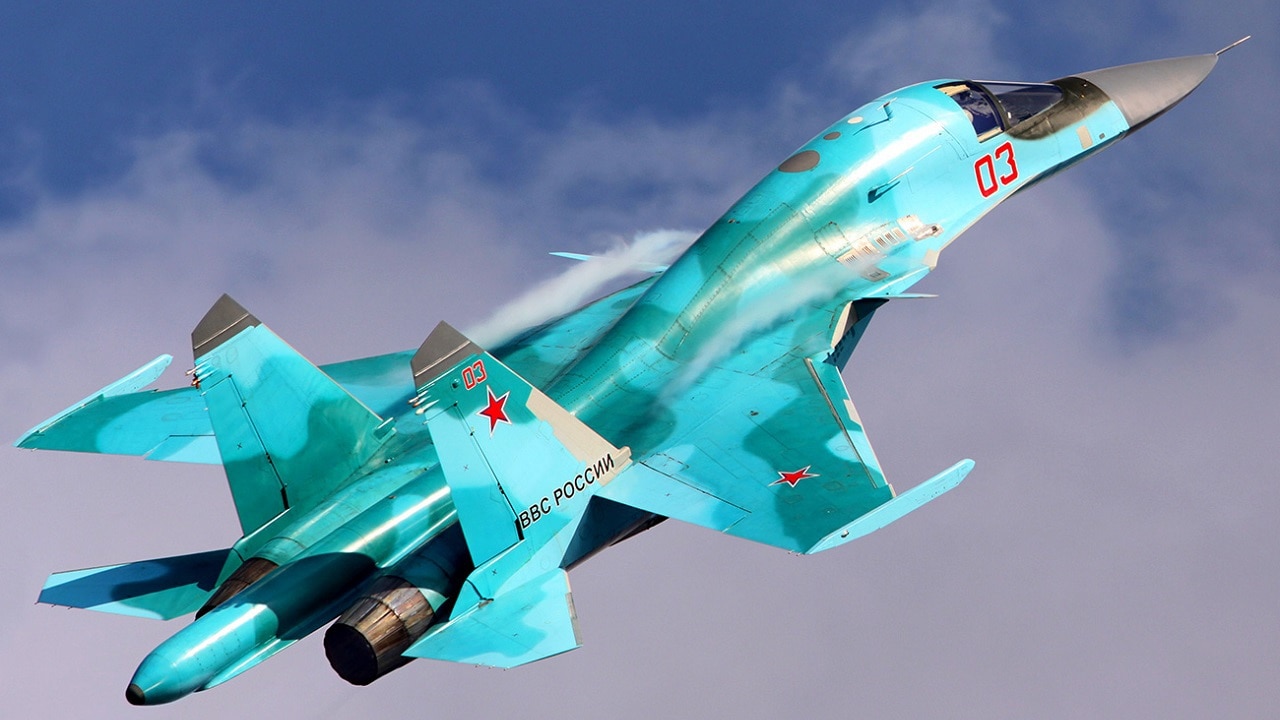
Russian Su-34. Image Credit: Creative Commons.
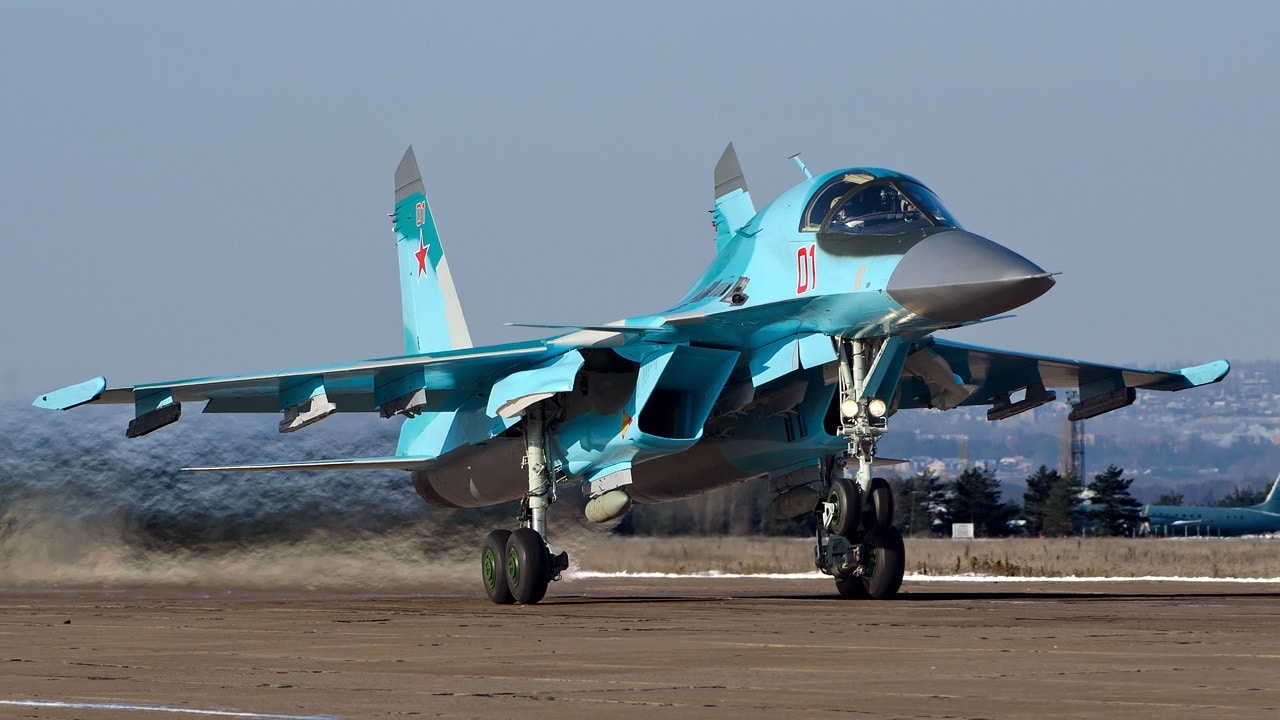
Russian Su-34 fighter-bomber. Image Credit: Creative Commons.
This arrangement was chosen to improve crew communication and coordination during complex, long-duration missions and to avoid the duplication of certain instruments and displays.
Embodying the “flying tank” design philosophy, the entire cockpit is constructed as an all-welded titanium armored “tub” or capsule.
This structure, reportedly 17 mm thick and weighing nearly 1,500 kg, is designed to protect the crew and critical avionics from small-arms fire and missile fragments, a feature intended to enhance survivability during low-level attack runs.
Reflecting its intended role as a long-range bomber that could replace even the Tu-22M, the cabin is designed for crew endurance. It is pressurized to allow operation up to 10,000 meters without the constant use of oxygen masks, which are reserved for combat or emergencies.
The space behind and between the K-36DM ejection seats is large enough for a crew member to stand up, stretch, or even lie down during long flights.
To facilitate missions that could last many hours, the aircraft is equipped with a small galley (including a microwave and water heater) and a lavatory in the form of a hand-held urinal.
Access to this unique cockpit is not via a conventional canopy, but through a hatch in the floor, with a built-in ladder that extends down from the nosewheel bay.
Avionics and Sensor Suite
The Su-34’s avionics suite was advanced for its time of design, though some elements have been surpassed by more modern Western systems.
- Forward Radar: The primary sensor is the Leninets Sh141/V004, a large passive electronically scanned array (PESA) multimode radar housed in the distinctive “platypus” nose. This system is heavily optimized for air-to-ground work, featuring terrain-following and terrain-avoidance modes for safe, high-speed, low-level flight. It is claimed to have a detection range of 200–250 km against large surface targets like a naval vessel and up to 120 km against fighter-sized aerial targets.
- Rearward Radar: The elongated tail “stinger,” which also houses an auxiliary power unit (APU), contains a rearward-facing warning radar. This system, initially the N012 and planned to be upgraded to the Kopyo-DL on the Su-34M, is designed to detect and warn the crew of pursuing aircraft or missiles, cueing the defensive systems.
- Targeting System: For precision strikes, the aircraft is fitted with the Platan electro-optical targeting system. This is a retractable unit housed in the fuselage belly that contains a television camera and a laser designator for guiding munitions. While effective in clear, daytime conditions, its capability is limited by its lack of a thermal imaging channel, making it less effective at night or in adverse weather compared to modern Western targeting pods like Sniper or Damocles.
- Electronic Warfare (EW): A key element of the Su-34’s survivability is its Khibiny (L-175V) electronic countermeasures (ECM) suite. This system, which includes internal components and distinctive torpedo-shaped pods on the wingtips, is designed to jam enemy radar systems and the seekers of incoming missiles. It functions by delaying detection, creating false targets, and distorting the adversary’s radar picture, with its manufacturer claiming it increases aircraft survivability by a factor of 25 to 30.
The Su-34’s design philosophy is clear: it is a specialist, not a generalist. The heavy armor, crew amenities, and fixed engine inlets sacrifice air-to-air agility and top speed for endurance and survivability in its primary ground-attack role. This deliberate focus made it a highly effective tool in the permissive air environment over Syria, where its long range and heavy payload could be used to full effect. However, in the contested, high-tech battlespace over Ukraine, these same design choices contributed to its vulnerabilities.
Modern air defenses more easily detect its large, non-stealthy airframe and PESA radar. At the same time, the lack of advanced precision-guided munitions forced it into dangerous low-level attack profiles where its armor was tested—and often defeated.
Table 1: Su-34 Fullback Key Specifications
|
Feature |
Specification |
|
|
Crew |
2 (Pilot and Weapon Systems Officer) |
|
|
Length |
23.34 m (76 ft 7 in) |
|
|
Wingspan |
14.7 m (48 ft 3 in) |
|
|
Height |
6.09 m (20 ft) |
|
|
Empty Weight |
22,500 kg (49,600 lb) |
|
|
Max Takeoff Weight |
45,100 kg (99,430 lb) |
|
|
Powerplant |
2 x Saturn AL-31FM1 afterburning turbofans |
|
|
Max Speed |
Mach 1.8 (1,900 km/h) at altitude |
|
|
Mach 1.2 (1,400 km/h) at sea level |
||
|
Combat Range |
1,100 km (680 mi) with typical weapons load |
|
|
Ferry Range |
4,000 km (2,500 mi) |
|
|
Service Ceiling |
15,000 m (49,200 ft) |
|
|
g-limit |
+9g |
|
|
|
Claws of the Fullback: A Deep and Versatile Arsenal
The Su-34’s value as a strike platform is defined by its ability to carry a massive and diverse array of ordnance. With 12 external hardpoints, it can be configured for a wide spectrum of missions, from close air support to standoff strategic strikes. Its maximum payload is cited by various sources as being between 8,000 kg and 14,000 kg.
Internal Cannon
For strafing and self-defense, the aircraft is equipped with the powerful 30mm Gryazev-Shipunov GSh-30-1 autocannon, a weapon common to the Flanker family, supplied with 150 to 180 rounds of ammunition.
Air-to-Surface Munitions (The Primary Role)
The Su-34’s primary purpose is to deliver ordnance onto ground and naval targets. Its arsenal represents a mix of Soviet-era brute force and modern precision.
- Unguided “Dumb” Bombs: The aircraft can carry a huge variety of unguided bombs, including the 250 kg FAB-250, 500 kg FAB-500, and the massive 1,500 kg FAB-1500 general-purpose bombs. It can also deploy OFAB high-explosive fragmentation bombs and ZB-500 incendiary devices.
- Guided “Smart” Bombs: For precision strikes, the Su-34 employs the KAB series of guided bombs. These include the KAB-500 and KAB-1500, which can be fitted with laser (L), television (Kr), or satellite (S) guidance systems. This capability has been critically augmented in the Ukraine conflict by the widespread adoption of the UMPK (Unifitsirovannyi Modul Planirovaniya i Korrektsii), a kit that attaches wings and a guidance system to standard dumb bombs, converting them into standoff glide weapons.
- Guided Missiles: The Fullback’s standoff strike capability rests on its extensive suite of guided missiles:
- Anti-Radiation Missiles (ARM): For Suppression of Enemy Air Defenses (SEAD) missions, it can carry the Kh-31P/PD (NATO: AS-17 Krypton) to home in on and destroy enemy radar emitters.
- Anti-Ship Missiles (AShM): For maritime strike, its arsenal includes the Kh-31A, the Kh-35U, and the large, long-range Kh-59M “Ovod”.
- Tactical Land-Attack Missiles: A wide range of missiles for striking ground targets includes the heavy Kh-29L/T (laser/TV-guided), the smaller Kh-25ML (laser-guided), and the more modern Kh-38M family.
- Unguided Rockets: For saturating area targets, the Su-34 can be armed with pods for S-8, S-13, and heavy S-25 rockets.
Air-to-Air Munitions (For Self-Defense)
Although it is a bomber first and foremost, the Su-34 is not defenseless. It is equipped to carry a formidable air-to-air loadout, allowing it to engage hostile fighters and protect itself without relying entirely on a dedicated escort.
- Short-Range: Vympel R-73 (NATO: AA-11 Archer) infrared-homing missiles, known for their high off-boresight capability and agility in a dogfight.
- Medium/Long-Range: Vympel R-27 (NATO: AA-10 Alamo) missiles in semi-active radar (R/ER) and infrared (T/ET) variants, and the more modern Vympel R-77 (NATO: AA-12 Adder), an active radar-homing “fire-and-forget” missile comparable to the American AMRAAM.4
This extensive documented arsenal, however, represents a powerful potential that has not always translated into reality. The Su-34’s combat employment has revealed a significant gap between its designed capabilities and its actual use, particularly in Ukraine. Its reliance on unguided bombs and the subsequent emergency adoption of the UMPK glide-bomb kits is not a sign of tactical flexibility, but rather a symptom of a critical failure in the Russian defense-industrial base.
Analysis of downed Russian equipment has shown a heavy dependence on Western-made microelectronics for precision-guided munitions (PGMs). With these components cut off by international sanctions, Russia has been unable to produce its advanced PGMs in sufficient quantities. The UMPK is a direct consequence of this shortage—a low-cost, technologically simple stopgap to give unguided bombs a standoff capability. This adaptation allows the Su-34 to remain relevant by staying outside the range of many air defenses, but it reveals a systemic weakness: Russia’s most advanced tactical bomber is operationally constrained by its own country’s limited high-tech manufacturing capacity.
Table 2: Su-34 Armament Suite
|
Category |
Designation |
Type / Guidance |
|
|
Cannon |
GSh-30-1 |
30mm Autocannon |
|
|
Air-to-Air Missiles |
R-73 (AA-11 Archer) |
Short-Range, Infrared Homing |
|
|
R-27R/ER (AA-10 Alamo-A/C) |
Medium-Range, Semi-Active Radar Homing |
||
|
R-27T/ET (AA-10 Alamo-B/D) |
Medium-Range, Infrared Homing |
||
|
R-77 (AA-12 Adder) |
Medium-Range, Active Radar Homing |
||
|
Air-to-Surface Missiles |
Kh-29L/T (AS-14 Kedge) |
Tactical, Laser/TV Guided |
|
|
Kh-38M |
Tactical, Modular Guidance |
||
|
Kh-25ML (AS-10 Karen) |
Tactical, Laser Guided |
||
|
Kh-31P/PD (AS-17 Krypton) |
Anti-Radiation (SEAD) |
||
|
Kh-31A (AS-17 Krypton) |
Anti-Ship |
||
|
Kh-35U (AS-20 Kayak) |
Anti-Ship |
||
|
Kh-59M (AS-18 Kazoo) |
Standoff / Anti-Ship |
||
|
Guided Bombs |
KAB-500L/Kr/S |
500 kg, Laser/TV/Satellite Guided |
|
|
KAB-1500L/Kr |
1,500 kg, Laser/TV Guided |
||
|
UMPK Glide Bombs |
Unguided bombs with standoff glide kit |
||
|
Unguided Bombs |
FAB-250/500/1500 |
250/500/1,500 kg General Purpose |
|
|
OFAB Series |
High-Explosive Fragmentation |
||
|
Rockets |
S-8, S-13, S-25 |
80mm, 122mm, 266mm Unguided Rockets |
|
Section 4: Trial by Fire: Combat Performance from Syria to Ukraine
The Su-34’s operational history is a tale of two vastly different conflicts, which have painted starkly contrasting pictures of the aircraft’s effectiveness. Its performance in Syria created a narrative of a highly capable, modern strike platform, while the war in Ukraine provided a brutal reality check that exposed its vulnerabilities and the doctrinal flaws of the force that operates it.
The Syrian Proving Ground (2015-Present): A Narrative of Success
The Su-34 made its combat debut in September 2015 as part of Russia’s military intervention in the Syrian Civil War.
An initial deployment of just four aircraft to Khmeimim Airbase was later reinforced as the campaign progressed.
In the largely permissive air environment over Syria, where opposition forces lacked any significant air defense capabilities, the Su-34 was able to operate largely as its designers had intended.
Its primary mission profile consisted of precision strikes from medium to high altitudes (often above 5,000 meters) against fixed targets such as command centers, ammunition depots, training camps, and fortified bunkers.
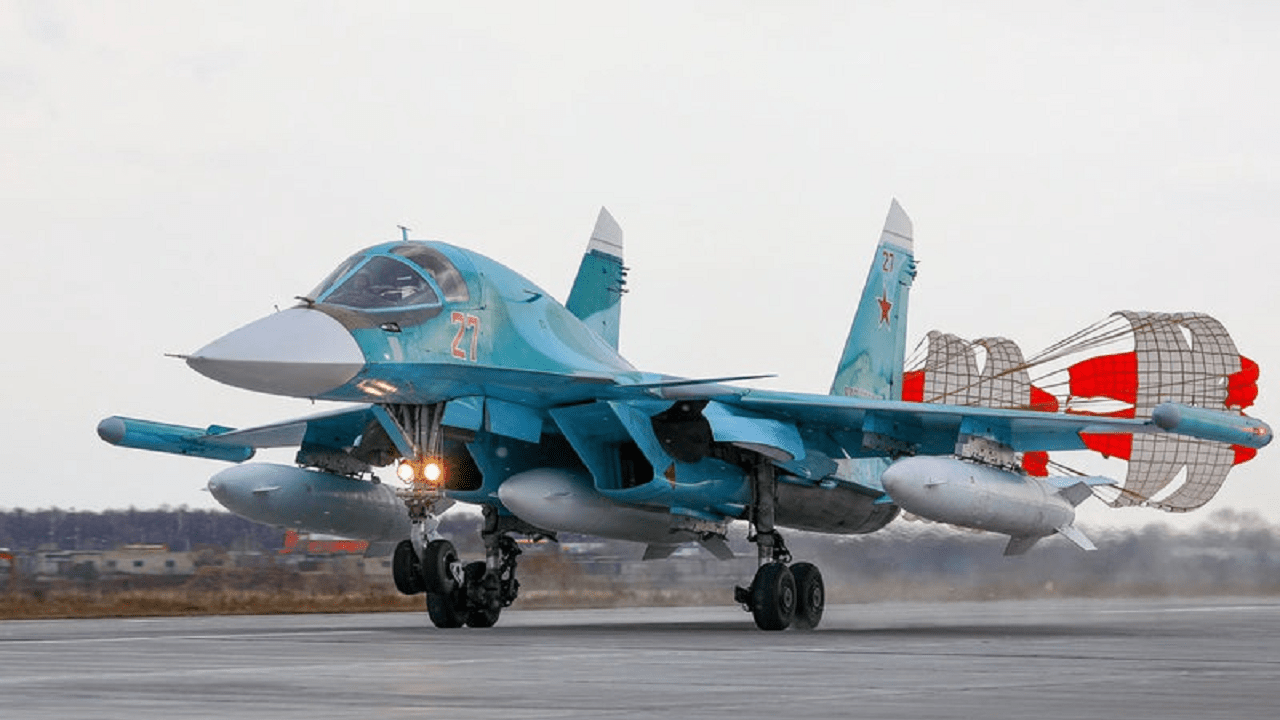
Russian Su-34 fighter-bomber. Image Credit: Creative Commons.
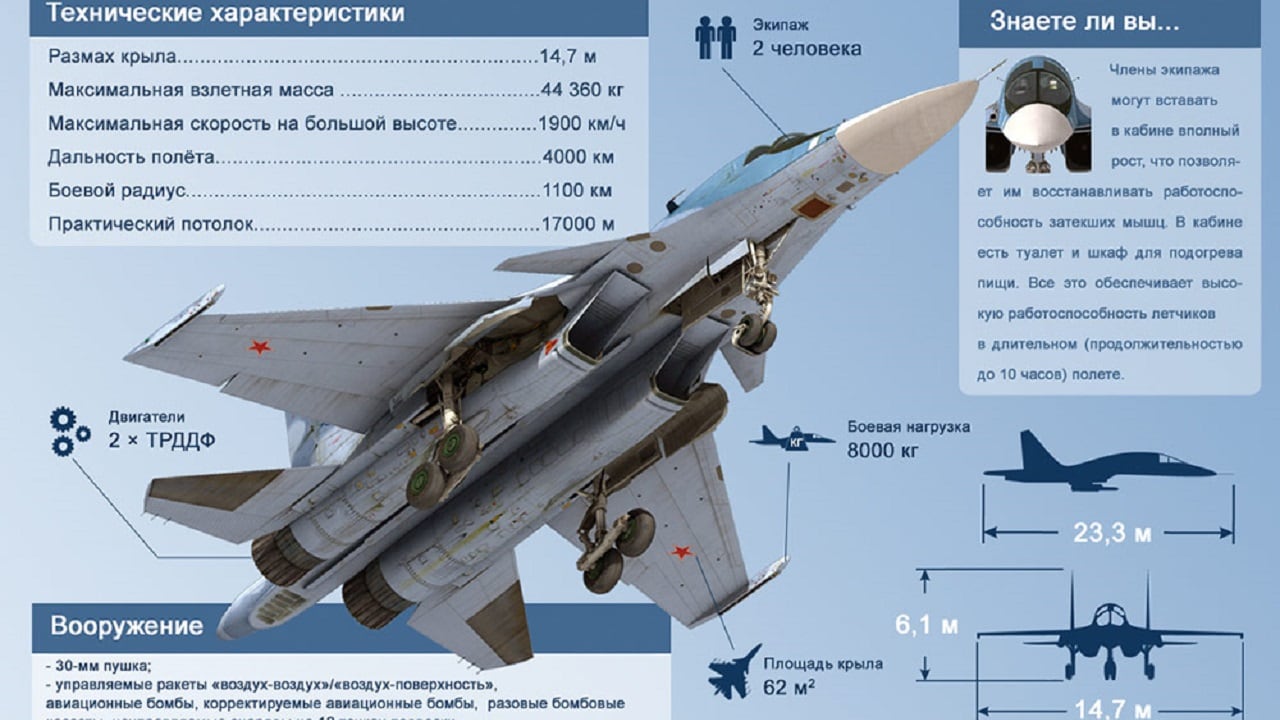
Russian Su-34. Image Credit: Russian Military.

In this role, it successfully employed a range of PGMs, most notably the KAB-500S satellite-guided bomb, demonstrating its capacity for accurate, all-weather strikes.
The Syrian campaign became a powerful marketing and propaganda tool for the Su-34. It was hailed by Russian defense officials as the most advanced and effective aircraft in the theater and was seen as instrumental in ensuring the survival of the Assad regime.
This perceived success likely played a significant role in securing Russia’s first export order for the aircraft from Algeria.
The Ukrainian Crucible (2022-Present): A Brutal Reality Check
If Syria was the Su-34’s showcase, Ukraine has been its crucible. The high-intensity conflict against a well-equipped and determined adversary has been devastating for the Fullback fleet. At the start of the 2022 invasion, Russia possessed an estimated 125 to 140 Su-34s.
As of mid-2024, open-source intelligence analysis has visually confirmed the loss of at least 36 of these aircraft, with Ukrainian forces claiming to have downed dozens more.
These losses have been sustained not only from enemy fire in the air but also from Ukrainian long-range drone and sabotage attacks on Russian airbases deep behind the front lines.
The war has exposed critical tactical vulnerabilities:
- Forced Low-Altitude Attacks: The chronic shortage of PGMs forced VKS pilots to fly low-altitude missions to have any chance of accurately delivering unguided “dumb” bombs. This tactic brought the large, non-stealthy Su-34 directly into the lethal engagement envelope of Ukraine’s highly effective and mobile short-range air defenses (SHORAD), including man-portable systems (MANPADS) like the Stinger and RBS-70, and self-propelled anti-aircraft guns like the German-made Gepard.
- Vulnerability to Advanced SAMs: When operating at medium altitudes to stay above the SHORAD threat, the Su-34 proved vulnerable to more sophisticated, long-range surface-to-air missile (SAM) systems. Ukrainian forces, using Western-supplied systems like the MIM-104 Patriot, have successfully conducted tactical “SAMbushes,” downing multiple Su-34s in short periods by moving the launchers to unexpected locations near the front.
- Ineffective Electronic Warfare: The vaunted Khibiny ECM suite, despite its impressive on-paper specifications, has proven insufficient against modern, networked air defense systems employing advanced electronic counter-countermeasures (ECCM) and missiles with sophisticated seekers. The high loss rate suggests a significant gap between its theoretical capabilities and its real-world performance in a dense, contested electronic environment.
These losses are not solely the fault of the aircraft’s design. They are symptomatic of broader VKS doctrinal and logistical failures, including an inability to conduct an effective Suppression/Destruction of Enemy Air Defenses (SEAD/DEAD) campaign in the opening phase of the war, a persistent lack of coordination, and a tendency to fly predictable routes.
Attacks are often conducted by small formations of one or two aircraft rather than large, integrated strike packages, making them easier to intercept.
The primary Russian tactical adaptation to this lethal environment has been the mass deployment of UMPK glide bomb kits. This innovation allows the Su-34 to release its heavy FAB-500 and FAB-1500 bombs from standoff ranges of 35-45 km or more, keeping the launch aircraft outside the reach of most of Ukraine’s frontline air defenses.
While this has reduced the attrition rate of the Su-34 fleet, it has transformed the aircraft’s role into that of a relatively indiscriminate glide bomb “truck,” a far cry from the high-tech precision striker it was designed to be.
A Tale of Two Philosophies: Su-34 Fullback vs. F-15E Strike Eagle
To fully understand the Su-34, it is essential to compare it with its closest conceptual counterpart in the West: the American F-15E Strike Eagle.
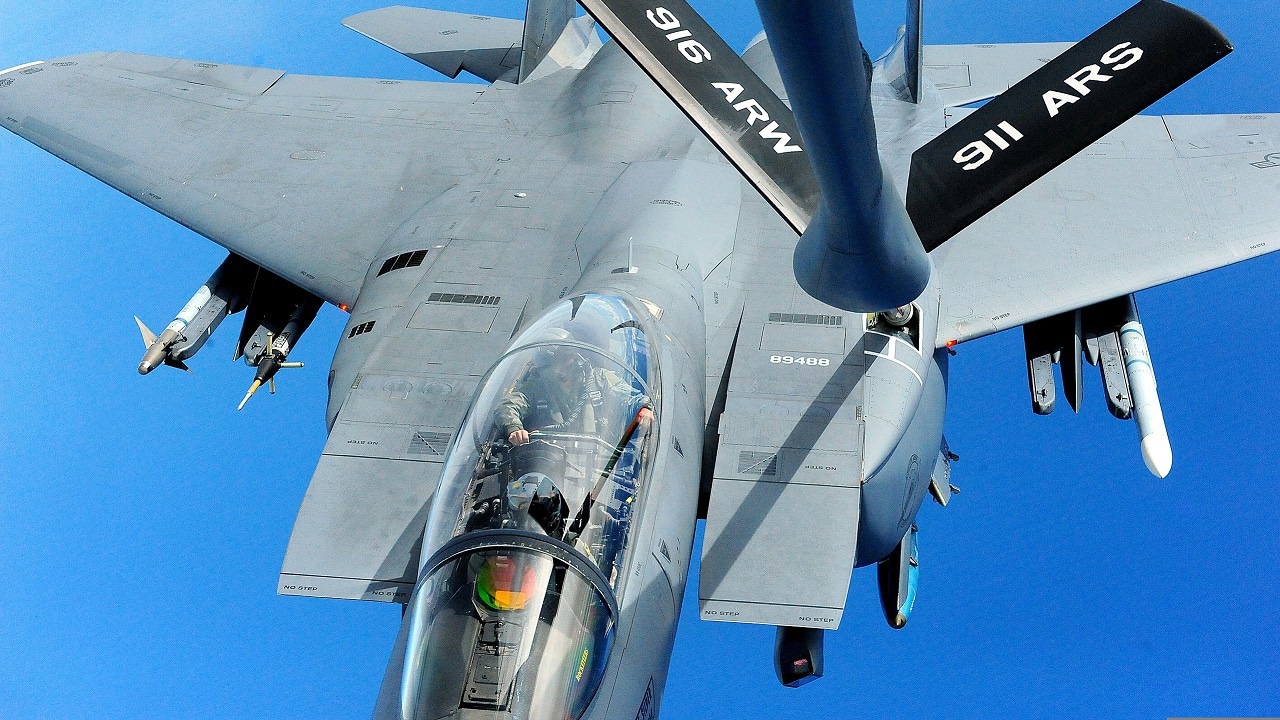
F-15E fighter. Image Credit: Creative Commons.
While both are two-seat, twin-engine aircraft designed for deep-strike missions, they are the products of vastly different design philosophies, technological capabilities, and military doctrines.
Core Design Philosophy
The fundamental difference lies in their origins.
- Su-34: The Bomber That Can Fight. The Su-34 is, at its core, a tactical bomber. Its design heavily prioritizes payload, range, and crew survivability (via its armored cockpit) for long, deep-penetration missions into hostile territory. Its air-to-air capabilities, while robust, are primarily for self-defense rather than offensive counter-air operations.
- F-15E: The Fighter That Can Bomb. The F-15E is a true multirole fighter. It was developed from one of the world’s most successful air superiority platforms, the F-15 Eagle, and it retains nearly all of its parent’s formidable air-to-air lethality. Its air-to-ground capability was added without fundamentally compromising its performance as a fighter.
Performance and Technology Comparison
This philosophical divergence is reflected in their performance metrics and technology.
- Speed and Agility: The F-15E holds a clear advantage. It is significantly faster (capable of Mach 2.2+ versus the Su-34’s Mach 1.8) and far more maneuverable, boasting a much higher thrust-to-weight ratio (approximately 0.93 compared to the Su-34’s 0.68). An F-15E, if forced into a dogfight, can perform as a lethal air superiority fighter; an Su-34 would be at a severe disadvantage against a dedicated fighter platform.
- Range and Payload: Here, the aircraft are more comparable, reflecting the Su-34’s focus as a bomber. The Fullback has a slightly greater ferry range on internal fuel and can carry a marginally heavier maximum ordnance load (up to 12,000-14,000 kg vs. 10,400 kg for the Strike Eagle). However, in practical combat loadouts, the F-15E often has a superior combat radius.48
- Avionics and Sensors: The F-15E has a distinct technological edge. Modernized Strike Eagles are equipped with Active Electronically Scanned Array (AESA) radars like the AN/APG-82, which are generations ahead of the Su-34’s PESA system in terms of range, resolution, multi-targeting capability, and resistance to electronic jamming. Furthermore, the F-15E’s integration with advanced targeting pods like the Sniper ATP provides superior imaging and targeting capabilities compared to the Su-34’s internal Platan system.
Operational Conclusion
The F-15E is a more flexible, technologically advanced, and capable multirole platform. The Su-34 is a more specialized, rugged, heavy-payload strike aircraft. In a one-on-one air-to-air engagement, the F-15E would be overwhelmingly favored. In an uncontested air-to-ground scenario, the Su-34’s ability to haul a massive bomb load over long distances makes it a formidable bomber.
However, in the complex, networked battlefields of the 21st century, the Strike Eagle’s superior sensor fusion, data links, and true multirole flexibility give it a decisive advantage.
Table 3: Su-34 vs. F-15E: A Comparative Overview
|
Metric |
Su-34 Fullback |
F-15E Strike Eagle |
|
|
Design Philosophy |
Tactical bomber with self-defense capability |
Multirole fighter with strike capability |
|
|
Max Speed |
Mach 1.8 |
Mach 2.2+ |
|
|
Thrust/Weight Ratio |
~0.68 |
~0.93 |
|
|
Combat Radius |
~1,100 km (680 mi) |
~1,270 km (790 mi) |
|
|
Max Payload |
12,000 – 14,000 kg |
10,400 kg |
|
|
Radar Type |
PESA (Passive Electronically Scanned Array) |
AESA (Active Electronically Scanned Array) |
|
|
Air-to-Air Capability |
Primarily defensive; retains Flanker missiles |
Excellent; retains F-15’s full lethality |
|
Conclusion – The Future of a Battle-Scarred Fleet
The Sukhoi Su-34 Fullback will remain a cornerstone of Russia’s tactical aviation for decades to come, but its role has been irrevocably altered by the brutal lessons of the war in Ukraine. The “flying tank” designed for low-level penetration has been forced to evolve into a standoff missileer, a transformation that reflects the lethal realities of modern air warfare. Its long-term viability now depends less on its armored cockpit and more on the sophistication of its sensors, weapons, and the electronic warfare systems that shield it from afar.
The modernization program that produced the Su-34M variant is not a routine, pre-planned life extension but a direct and urgent reaction to the combat vulnerabilities exposed since 2022.
The upgrades are squarely focused on correcting these deficiencies by enhancing standoff capabilities.
This includes the integration of new, more capable reconnaissance and targeting pods (developed under the “Sych” program), an upgraded Khibiny EW suite to better counter modern threats, and an expanded arsenal of new precision weapons to close the PGM gap that has plagued its operations.
There are also reports that the Su-34M may be fitted with the more powerful Saturn AL-41F1S engines from the Su-35 program, likely to improve performance when carrying the heavy glide bomb loads that have become its new primary armament.
Despite heavy attrition, Russia continues to produce new Su-34s at the Novosibirsk plant to replenish its fleet, with new batches delivered in 2023 and 2024.
However, while airframes can be replaced, the experienced and highly trained crews lost over Ukraine represent a far more significant and long-lasting blow to the VKS’s combat capability.
Ultimately, the Su-34’s story is a cautionary tale about the nature of military evolution. An aircraft conceived in the final days of the Cold War, delayed by a nation’s collapse, and celebrated in a low-intensity conflict, was ultimately found wanting when tested in the fires of a major peer-level war.
Its future, embodied by the Su-34M, is one of adaptation driven by necessity. It will continue to serve as a vital heavy payload carrier, but its effectiveness will be perpetually defined by a tense competition between the reach of its standoff weapons and the ever-advancing capabilities of enemy air defenses.
About the Author: Harry J. Kazianis
Harry J. Kazianis (@Grecianformula) is a national security expert based in Orlando, Florida. Kazianis was Senior Director of National Security Affairs at the Center for the National Interest (CFTNI), a foreign policy think tank founded by Richard Nixon, based in Washington, DC. He also served as Executive Editor of its publishing arm, The National Interest. Harry has over a decade of experience in think tanks and national security publishing. His ideas have been published in the NY Times, Washington Post, Wall Street Journal, CNN, and many other outlets worldwide. He has held positions at CSIS, the Heritage Foundation, the University of Nottingham, and several other institutions related to national security research and studies.
